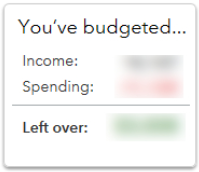Cover Your Budgeting Bases: Position Yourself To Win With Money

Photo by KeithJJ, CC0 1.0 license
Budget, budgets, and budgeting. If you read those words and picture something akin to handcuffs, a ball and chain, or an experience about as enjoyable as plucking a nasal hair, you’re not alone. These words possess a negative connotation in the minds of many.
Based on your own past experience or perhaps someone else’s horror story, you might even believe that budgeting and the concept of financial freedom are diametrically opposed to one another.
But the relationship of budgeting to financial freedom isn’t that of a necessary evil, or even a means to an end. Done right, budgeting actually serves as the key to removing those handcuffs you’re envisioning, along with that ball and chain.
Every baseball infielder undergoes training on how to strategically position themselves to win in closely-contested circumstances at the bag. My goal is to show you how to cover the budgeting bases so you can start positioning yourself to win with your money.
Table of Contents
Why Many Budgets Fail
Like diets, budgets are a popular New Year’s resolution. But as with diets, many people make it only a few weeks or months with their new budget before falling off the proverbial wagon.
Have your previous attempts to master your money bronco resulted in being unceremoniously dumped on your head? If so, chances are it was due to one of the following reasons:
- System was too complicated
- Budget took too much time or effort to maintain
- Non-customized one-size-fits-all approach or system used
- System failed to link your budget to your ability to obtain your financial freedom
Pro athletes perform film analysis to identify opponent’s weaknesses so they can work to counter them. Let’s break down the film on these typical fail points to better understand how to cover our budgeting bases.
Too Much Complexity, Time, & Effort
Many budgeting systems fail users due to their level of complexity or the corresponding amount of time and effort required. Monkeying around with spreadsheets. Burning the midnight oil at the kitchen table. Filling out countless forms. If budgeting is as complicated as filing taxes, no wonder it has a bad rap.
A Static, One-Size-Fits-All Approach
A whole host of budgeting templates and systems set a predefined formula for the percentage of your money assigned to bills, discretionary income, and savings. These templates are often referred to by the percentage they assign to these categories, such as a 70/20/10 plan.
These plans are one-size-fits-all and completely fail at supporting your personal financial goals. Consider two individuals who both possess a $100,000 mortgage. Both desire to pay this mortgage off early in order to save hundreds of thousands of dollars in interest. However, one individual has only half the income of the other. These two individuals can’t both follow a 70/20/10 plan and expect the same results. The individual with the lower income can potentially still pay his house off in the same time-frame as the other, but to do so he or she would need to pursue a much more aggressive rate of savings.
Income levels and savings goals differ widely, as do definitions of financial freedom. One-size-fits all budget templates are better than nothing, but they are rank with inefficiency and typically drop the ball when it comes to supporting aggressive financial goals.
Budgeting For Budgeting’s Sake Alone
Many people attempt to implement a budget because they know their money is out of control. Others do so out of a sense of responsibility or duty. But having a budget simply for its own sake is what contributes to the perception that budgets are controlling, limiting, and burdensome.
Budget templates or systems which fail to focus on and be driven by delivering the savings goals of an individual are bound to fail. If for no other reason, simply because saving for the sake of saving alone isn’t enough of a motivator for most people. Systems which do not center the entire budget process on savings goals are bound to make it feel like a burden rather than a key to lifestyle freedom.

Photo by KeithJJ, CC0 1.0 license
What Makes The Financial Freedom Project Budget Approach Different?
With the above list of challenges in mind, let’s take a look at the Financial Freedom Project Budget approach to see how it can succeed where others have failed.
Simplicity & Automation Through Mint
The FFP Budget avoids issues associated with complexity, time, or effort thanks largely to leveraging the automation offered by Mint, which performs all of the budgeting grunt work for you. This frees you up to focus less on budget maintenance and more on, you know, life.
Sure, there’s a bit of initial setup and configuration involved. But once you’re up and running, this system is designed to run on cruise control. Monitoring the status of your bills, tracking your spending, and reporting your progress towards savings goals? Done for you, automatically.
Customized To Support Your Ideal Lifestyle
Flexibility and configurability are core strengths of the FFP Budget. Unlike one-size-fits-all templates, this is a system designed to work for you, rather than the other way around. Don’t force your finances to fit some predetermined percentages – find the right balance of spending to saving for your lifestyle.
This approach will ensure that you can be as aggressive with the pursuit of your financial goals as you like. This is a requirement if you’re deep in debt and want to have any hope of getting out or of getting ahead. It’s also required for households with modest incomes to achieve aggressive financial goals such as financial independence or early retirement.
Centered On Your Savings Goals & Financial Freedom
The FFP Budget is entirely centered on achieving your savings goals and, ultimately, your desired level of financial freedom. Reverse-engineering every aspect of your financial plan from your goals makes them and keeps them the primary focus. This approach ensures that your discretionary spending does not interfere with your long-term lifestyle goals.
With a plan centered on your goals, you can connect the dots between your spending and its impact on them. You’ll no longer be budgeting simply for the sake of budgeting alone. You’ll be budgeting to chart a Money Map that will guide you to your goals and your desired lifestyle.
This is the key to the required paradigm shift on viewing budgeting as a freeing experience rather than a limiting one. I’m a firm believer that this is the only truly sustainable way to implement budgeting.

Photo by 12019, CC0 1.0 license
The Four Bases Of Budgeting
Budgeting doesn’t need to be overly complicated, so let’s break it down. The Financial Freedom Project Budget contains four bases, just like a baseball diamond:
- First Base – Income
- Second Base – Bills & Non-Discretionary Spending
- Third Base – Savings Goals
- Home – Discretionary Spending
In this article and those forthcoming within the balance of the Master Your Money series, you will learn the ins and outs of how to properly cover each of these bases. In this article, we’ll only be covering first and second. But by the end of the series, you’ll be a highly-skilled utility infielder capable of playing first, second, third, or home!
First Base – Budgeting Your Income
Just like on the diamond, covering first base is pretty straight-forward. First things first (pun definitely intended), we need to know what we’re working with by way of wage or self-employment income.
Determine Net Monthly Wage Income
For our purposes this consists of your gross income per pay period minus all taxes, wage garnishments, or mandatory paycheck deductions for things like medical or dental premiums. If you are contributing to tax-deferred retirement, flexible spending, or health savings accounts, include your contributions to those accounts in this number. This may result in your “net wage” calculation potentially differing from your actual take-home pay.
Calculate the monthly totals of all wage and self-employment income for each wage earner as outlined below:
- Multiply net wage income by four if paid weekly.
- Multiply net wage income by two if paid every two weeks.
- No multiplication is required if paid monthly.
If income fluctuates from week to week, use an approximate weekly average. You can use Mint’s Trends feature to identify average weekly take-home pay if you have completed the action items in the last article. You will need to add the value of any retirement account contributions to the take-home pay reported in Mint if you use this approach.
Once you’ve calculated the monthly totals for each wage earner, add all net wage income together to obtain a monthly household total.
Identify Sources Of Monthly Non-Wage Income
Next, identify any consistent sources of monthly non-wage income for your household. This could be in the form of rental income, side hustle income, or savings account interest, to name just a few. Do not include any investment income such as dividends, or inconsistent sources of income like that from garage sales.
If you earn non-wage income weekly instead of monthly, calculate it based on four weeks per month. Mint Trends is excellent at helping you identify inconsistent income sources, amounts, and frequency. I highly recommend using the “Income By Category” and “Income Over Time” chart types for this purpose.
Create Budgets For All Monthly Income In Mint
Now that you’ve calculated your monthly income, it’s time to set up your first budget in Mint! Navigate to Mint Budgets and create a budget for each source of consistent monthly income using the numbers you calculated above. Mint may have already created a recommended budget for you. If not, creating one is an easy out, as the below one-and-a-half minute video demonstrates:
Second Base – Budgeting Your Bills & Non-Discretionary Spending
Now that you’ve mastered the relative simplicity of covering first base, it’s time to move on to second. As in baseball, there are more scenarios and techniques to master here than there are at first. That said, if you use the techniques outlined below you will be able to start turning double plays with ease.
Second base in the FFP Budget is all about identifying and budgeting your current expenses in the form of bills and non-discretionary spending. These two spending types are the least flexible and therefore should be accounted for in your budget immediately after income.
We’ll cover how to reduce expenses in both of these areas later on when we get into detailed savings strategies. For the time being, you simply need to identify how much of your income is consumed by each of these categories.
Review Monthly Bills In Mint
First batter up – bills. This is typically the most important form of required spending since bills are often non-negotiable. As such, you need to total the value of all of your bill payments and subtract them from your available monthly income.
If you’ve been following the Master Your Money series from the beginning, you’ve spent quite a bit of time practicing the fundamentals required of this position already. By now, you should already have a bill pay safety net in place and be saving money with online bill pay.
This is where some of your previous training will start to really pay off. Check your Mint Bills page to quickly review all of your existing bills. Your online bill types will automatically display their balance due for the current month. Offline bills should either display the same or an average amount that you’ve entered manually.
Create Budgets For Monthly Bills In Mint
Now you need to simply create budgets in Mint for all of your household’s recurring weekly and monthly bills. If you pay a given bill weekly rather than monthly, calculate its monthly total based on four weeks per month. Do not include bills which you pay less frequently than once a month, as we’ll cover those later.
Using this information, reference the above video to create budgets for each of your bills in Mint. Mint may have already created some for you, so be careful not to duplicate them. Be certain to review and update the amount and frequency of all bill-related budget categories which already exist.
Identify Monthly Non-Discretionary Spending
Now that we have budgets created in Mint to reflect all of your bills, it’s time to move on to the second-most important type of expense – non-discretionary spending. This consists of spending required for basic necessities rather than leisure activities or entertainment.
Common forms of non-discretionary spending include groceries, housing payments, medications, gasoline or public transportation costs, pet food, household supplies, and (potentially) tithe, pending your belief system.
Conversely, examples of discretionary spending which should not be included consist of vacations, dinners out, ready-made coffee, vending machine snacks, going to or renting movies, and the majority of all shopping for non-grocery or household supplies.
This is where Mint really starts to earn its keep. That solid foundation you laid brick-by-brick with such care after reading the last article now starts to really pay off. Use the Spending By Category pie chart in Mint Trends to view and create a list of all of your non-discretionary spending categories.
Create Budgets For Monthly Non-Discretionary Spending In Mint
Mint will have likely created some initial budget categories for you already on the Mint Budgets page. Review these categories and delete any that do not represent bills or non-discretionary spending types.
Reference the above video to create budgets for all of your non-discretionary spending categories. Use the charts in Mint Trends and the historical spending by month graphs displayed when creating a budget to determine monthly budget amounts.
Keep in mind that you shouldn’t try to set spending targets right now. You’re simply documenting what you historically spend in each category.

Photo by KeithJJ, CC0 1.0 license
Side Out
That’s it! You’ve now mastered the basics of covering first and second base of the Financial Freedom Project Budget. Like a sly second-baseman, you will continually refine your game by picking up additional tricks of the trade with more experience. But for now, you have the basics down.
Take a peek at the scoreboard to see how you’re doing. In this case, your scoreboard is the form located in the upper right corner of the Mint Budgets screen, pictured below. This form illustrates whether you have a projected monthly budget surplus or deficit based on the information you’ve entered thus far:

Time to head back to the dugout to digest this latest inning and compare notes with your teammates. When you take the field next, we’ll be focusing on eliminating the irregular bill scramble drill.
Next Steps
For those of you who have been following the Master Your Money series from the beginning, below are the next steps on your journey to financial freedom:
- Calculate your monthly household net wage income
- Calculate your monthly household net non-wage income
- Create budgets for all monthly net income types in Mint
- Review your Mint bills
- Review and edit any budgets automatically created for bills by Mint
- Create budgets for all remaining recurring weekly and monthly bills in Mint
- Use Mint Trends to identify your non-discretionary spending categories
- Review and edit budgets automatically created for these categories by Mint
- Create budgets for all remaining monthly non-discretionary spending categories in Mint
- Check the Mint Budgets Scoreboard to see your projected budget surplus or shortage



Join The Conversation!